Coastal missile complex "Utes"
Creation of the coastal anti-ship operational-tactical complex "Cliff" with the P-35B cruise missiles launched in 1961 in accordance with the decision of the Council of Ministers dated July 16. This document required to create a new stationary complex and equip them with existing bases in the Crimea and on. Kildin. The Utes system was to be a substitute for the existing Strela complex of a similar purpose, which no longer fully meets modern requirements. It is noteworthy that the new complex was to be a substitute for the old, not only in terms of a tactical role, but also in terms of accommodation. On the existing 100 Object and 101 Object complexes, it was necessary to dismantle the old Strely equipment and install new type of P-35B missile systems instead.
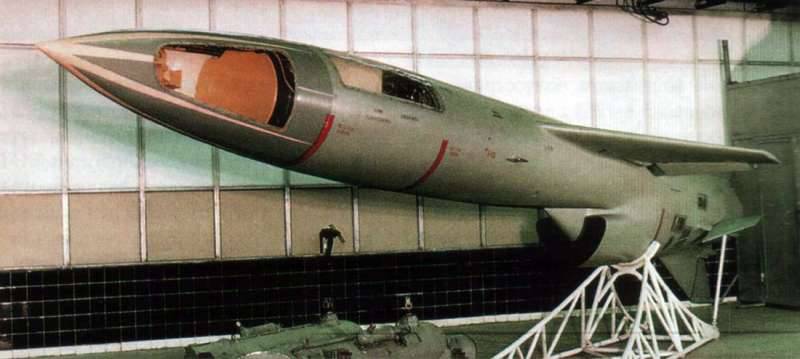
Model of the P-35 rocket with openings for demonstration of internal units. In particular, the radar antenna seeker is visible. Photo Bastion-karpenko.narod.ru
Need to remind history "100 Object" and "101 Object". As part of the creation of the Strela coastal complex with the C-2 rocket (due to the high degree of unification, it is often confused with the Sopka mobile system with the same rocket or called its stationary modification), which was carried out with the 1954 of the year, in the second half of the 1950s several special objects. In the middle of 1955, in the Crimea, in the area of Cape Aya, construction of the “100 Object” began. 95-e specialized management of underground work of the Black Sea Fleet punched in the rock a large number of tunnels and a set of special rooms, which were later placed various means of the missile complex.
In total, two complexes were built in the Crimea, classified as rocket battalions. Each of them had two launchers with two missiles each, missile controls, etc. Also located inside the mountain were command posts, missile storages, training stations and other premises. All underground structures connected poternny. On the surface there were only a few gates to access the complex and the launcher covers.
The Black Sea Fleet received two missile battalions, each of which had two launchers. One of these complexes was located near the town of Balaclava, the other was built near the village of Balaklava. Back up. The distance between the two divisions was about 6 km. In the same area, on the mountains of Cape Aya, the position of the detection radar was located. An interesting feature of all the facilities of the Strela complex was their location. All objects were located in the mountains at an altitude of 500-600 m above sea level. This hid them from observation from the sea, and also to a certain extent increased the range of observation and firing.
5 June 1957 of the Year "Object 100" conducted the first firing with the use of guided missiles C-2. After completion of all checks, 30 August, the complex was put into operation. Its operation was assigned to a specially formed 362-th separate coastal missile regiment (OBRP).
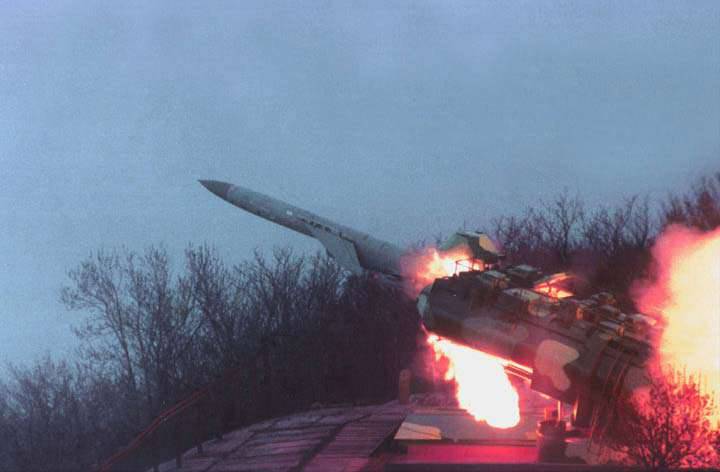
Rocket launch on "100 Object". Photos Flot.sevastopol.info
At the end of 1955, the second secret construction began on Fr. Kildin off the coast of the Murmansk region. The rocket base "Object 101", as in the case of the Crimean complex, had two autonomous divisions located in different parts of the island. In terms of general structure, the “101 Object” did not differ from the “100 Object”, but it was built using a different technology. Instead of making tunnels in the rock, it was decided to dig pits of the required size. They built all the necessary bunkers, rooms and worn, after which the free space was filled with soil and concrete.
The 101 Object should have been the new 616 OBRP formed in the 1957 year. In the early days of 58, a new missile system was put into operation. In the future, similar bases were not built. “100 Object” and “101 Object”, built to house the Strela missile systems, remained the only domestic stationary complexes of this class. In the future, priority was given to mobile coastal missile systems that do not need complex and expensive stationary objects.
Due to the obsolescence of existing C-2 missiles and complexes based on them, in the early sixties, it was decided to transfer two missile bases in the Crimea and on. Kildin on new weapons. The choice fell on the developed anti-ship cruise missile P-35B. Initially, this product was intended for the mobile coastal complex "Redoubt", but its characteristics allowed operation on stationary systems.
Perspective stationary complex received the symbol "Cliff". Its development was commissioned by OKB-52 under the direction of V.N. Chelomey. This organization has developed a number of anti-ship missiles, including the P-35. Thus, the creation of a new complex was entrusted to the design office, which is already working on a rocket for it: the Redut and P-35B projects started back in 1960 year.
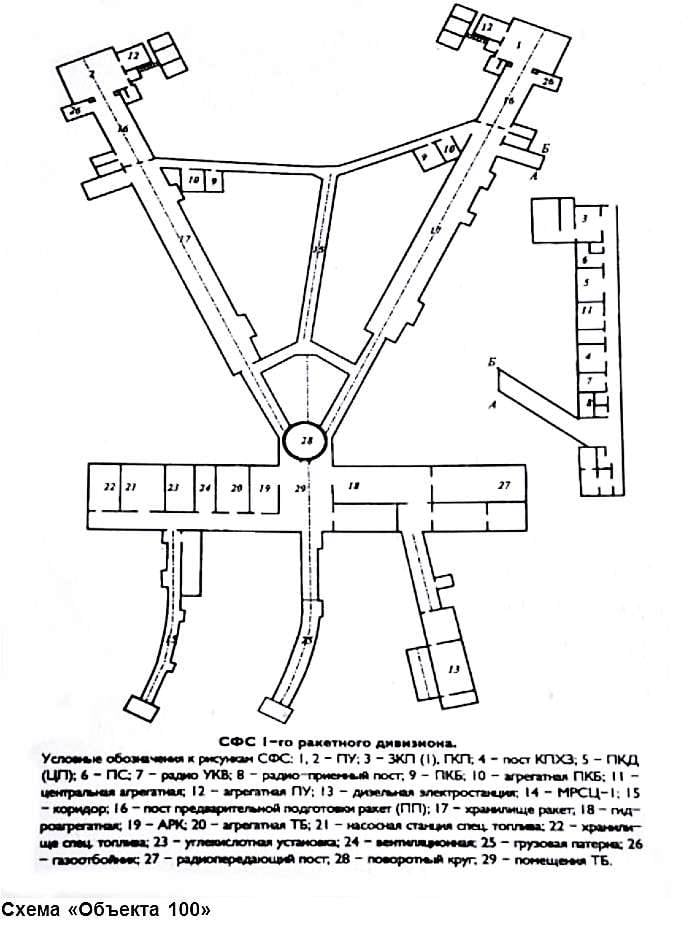
Scheme of the missile division as part of the "100 Object" and "101 Object". Figure Erlata.ru
It was proposed to use the P-35B rocket as part of the Utes complex. This product was a further development of the ideas embodied in the older projects of the mid-fifties. The missile was designed to attack large surface targets and had the appropriate technical appearance, as well as a special algorithm for the operation of guidance systems.
All the main missile units were placed inside the fuselage about 10 m long, equipped with a pointed head fairing and a protruding air intake under the bottom. An important feature of the P-35B rocket and its predecessors was the use of a folding wing. In the transport position, the arms were turned down, reducing the transverse dimension of the product to 1,6 m. After exiting the launch canister, the wing had to unfold and acquire a span of 2,6 m.
The power plant of the rocket was located in the rear fuselage. Its main element was a K7-300 turbojet propulsion engine 2180 kg. Also, the rocket was supposed to carry a detachable starting block in the form of two solid-fuel engines with a load of 18,3 tons. After the fuel had been developed, they had to be dumped. Also in the tail of the rocket were provided small elevators and a keel placed under the fuselage. At the last there was a rudder.
For targeting the missile P-35B had to use a combination of equipment. The exit to the area where the target was located should be carried out using an inertial navigation system when flying at altitudes up to 4-7 km. At a given distance from the target, an active radar homing head with a traverse mode should be connected to the work. With its help, the rocket was supposed to monitor the target area and search for objects located there, passing data about them to the operator. The task of the latter was the choice of targets for self-targeting missiles. After determining the target and its capture, the rocket should have completed the attack on its own, without the participation of the operator.
The defeat of the selected object should have been made with a high-explosive or special warhead weighing up to 1000 kg. The power of a nuclear warhead at the same time reached 350 kt, which made it possible to destroy both the target and the ships near it.
The P-35B rocket without a starting block and fuel for the main engine weighed about 2,33 tons. The launch weight reached 5300 kg, including the 800-kg starting engine. The rocket had the opportunity to climb to a height of 7 km and reach speeds of up to 1600 km / h. The exact flight parameters were determined in accordance with the selected flight program, however, the final segment in all cases was to take place at an altitude of 100 m. This did not interfere with correct targeting, but seriously hampered the timely detection and destruction of the flying missile.
To launch the missile from the coastal firing position, a special set of tools was developed, in which the groundwork was developed for the Strela project and the P-35 ship-based missile. The launcher for the P-35B missiles was created based on the SM-70 shipboard system and was a simplified version of it. Instead of four containers for rockets on a common basis with rotating mechanisms, there were now two. The containers provided guides for the movement of the rocket and other necessary equipment. During storage, the rocket was protected by movable covers lifted before launch.
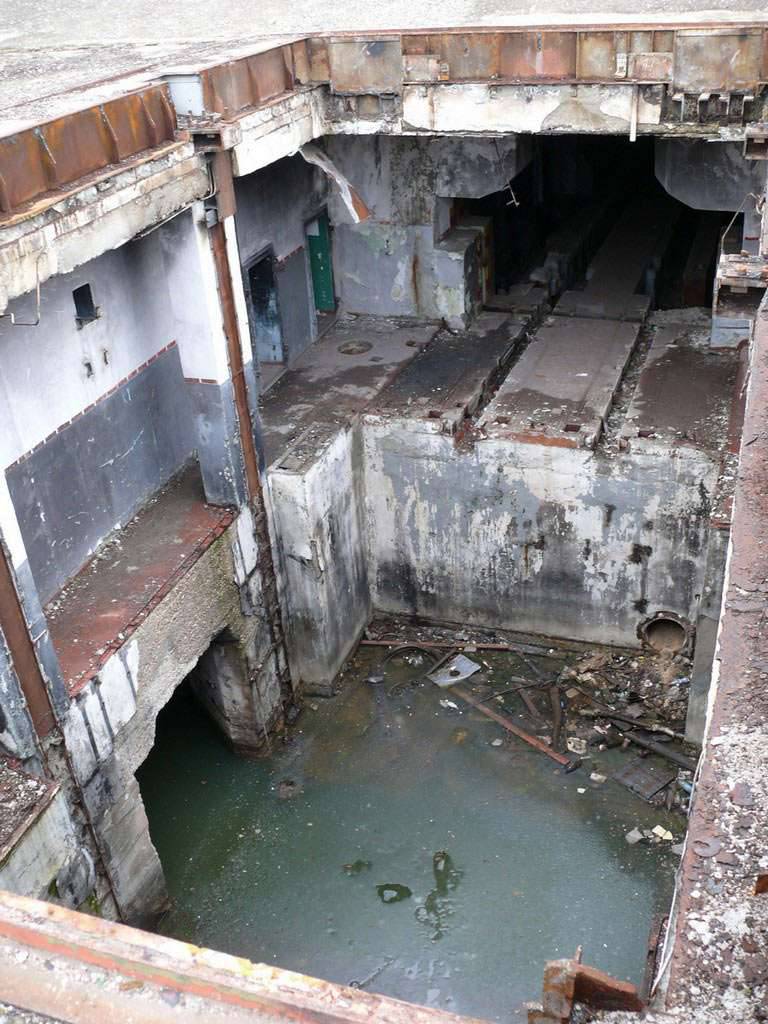
At the place of the launcher formed a pool. Photo by Jalita.com
Launchers of the new type should be mounted on lifting devices similar to those used in the Strela. Before the launch of the rocket, the launch complex had to open a sliding protected roof, ensuring the launch of the launcher. On the surface, the launcher was supposed to open the covers and rise with an elevation of + 15 °. After this, missiles could be launched. After start-up, the installation should be returned to the underground hall for recharging.
The complex "Cliff" provided various means for storing, transporting and servicing missiles. So, for loading the launcher, the P-35B rocket had to be supplied from the warehouse (rooms with racks on the 32 rocket) using a special trolley with an electric motor. On the trolley, it was proposed to deliver the rocket to the refueling station, and then place it in the launcher. All operations for the maintenance of the complex could be carried out by calculation without reaching the surface.
The coastal complex "Cliff" has retained some elements of its predecessor. So, it was suggested to monitor the protected area and search for targets using the radar “Mys”, which was already used with the Strela complex. Also some other units were unified. The use of the Mys radar allowed the new complex to fire P-35B missiles at a distance of up to 270-300 km. In the mid-sixties, a third-party targeting complex was adopted using several types of aircraft and helicopters. The use of aircraft, which solve the problem of long-distance reconnaissance and radio signal broadcasting, made it possible to bring the range of missiles to 450-460 km.
When developing the Utes project, the main features of the previous stationary complex were taken into account, but in some cases it was necessary to use significant modifications of the finished objects. As a result, these and other difficulties had a negative impact on the complexity of the work and on the timing of the modernization of the existing coastal missile bases.
At the beginning of autumn 1964, industry and Black Sea Fleet experts began the reconstruction and modernization of the “100 Facility”. All unnecessary facilities of the existing Strela were removed from the underground structures of the 2 Rocket Division (near the village of Reserve), and then they rebuilt some of the facilities in accordance with the dimensions of the new systems and other differences of the Utes complex. A little later, similar work started at the facilities of the 1 division. The restructuring of the existing structures in the mountain soil turned out to be quite a difficult task, because of what the builders did not manage to enter the established schedule.
After numerous difficulties and a shift in deadlines, the specialists nevertheless managed to complete the installation of the first complex, "Utes". All the necessary work was completed by the beginning of 1971. 28 May hosted the first test launch of the P-35B rocket on a training target. The rocket flew 200 km and successfully hit the target. At the end of April 1972, after six test launches, the “100 Object” was introduced into the permanent readiness forces. About a year later, by a decision of the Council of Ministers, he was officially put into operation.
Due to the difficulties inherent in the service in the North, the rearmament of the “101 Object” was delayed even more. The first division of the 616-th separate coastal missile regiment received all the new equipment only for the 1976 year. The retooling of the 2 division was completed after the end of work on the 1. Thus, he was able to start a full service using the new weapons only in the early eighties. Nevertheless, in spite of all the difficulties, the task was successfully solved: both stationary missile bases completely transferred to the new complex with modern missiles, differing in enhanced characteristics.
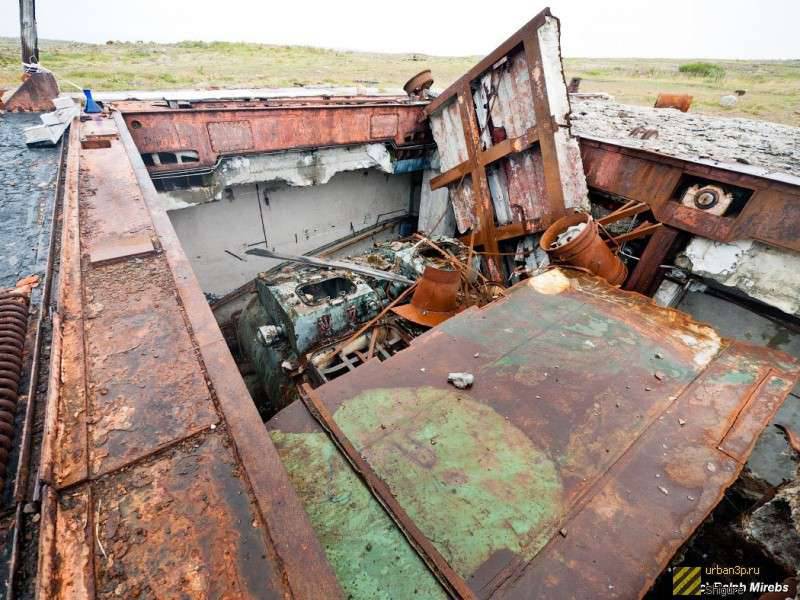
One of the launchers of the 101 Object. Due to lack of maintenance and harsh climate, the lid collapsed and fell inside. Photo Urban3p.ru
By the time of completion of the modernization of the database on about. Kildin was adopted by the new missile 3М44 Progress, which was an updated version of the P-35B. With maximum external similarity, this product differed from the base by using a large number of new assemblies and assemblies that positively influenced its characteristics. In connection with the advent of new missiles, all systems that previously used the P-35 and P-35B, began to switch to Progress. Thus, by the mid-eighties, the "100 Object" and "101 Object" could use both P-35B and 3М44. Interestingly, because of the lengthy work of the 2 division of the 616 OBRP, after upgrading from the very beginning, it received Progress missiles.
After returning to operation, two coastal missile complexes of the Black Sea and Northern Fleet repeatedly participated in combat training exercises with firing at target ships. In addition, from a certain time, these systems began to provide training for anti-aircraft gunners. In a number of exercises, P-35 family missiles were used as targets for naval anti-aircraft systems. It is with such exploitation that a very interesting review of the rocket is connected. After similar exercises, Admiral I.V. Kasatonov called the P-35B missile flying a tankas she continued to fly even after the detonation of two anti-aircraft missiles.
Full training and combat work of two separate coastal missile regiments lasted until the beginning of the nineties. The collapse of the Soviet Union and the subsequent problems of a political and economic nature seriously hit the cliff complexes. So, "Object 100" last time launched a rocket in September 1993, after which it was idle for several years. As part of the agreement on the division of the Black Sea Fleet in 1996, the complex departed from the Ukrainian side. According to some reports, in the 1997 year, the new owners were even able to make one training launch of the rocket, after which no major measures were taken. Not having the possibility of operating the Crimean base, the Ukrainian Navy took some actions that led to negative consequences.
The 1 Division, located near Balaklava, was disbanded at the beginning of the two thousandth. Left unattended and unguarded, the object was looted. At present, it is a harsh and sad spectacle: the equipment has disappeared or is destroyed, and under the open covers of the halls with launchers, real ponds with stagnant water have formed. Restoration and further operation of the facility is not possible. Probably, the former position of the 1 division of the 342 OBDR will remain a collapsing monument to a unique complex.
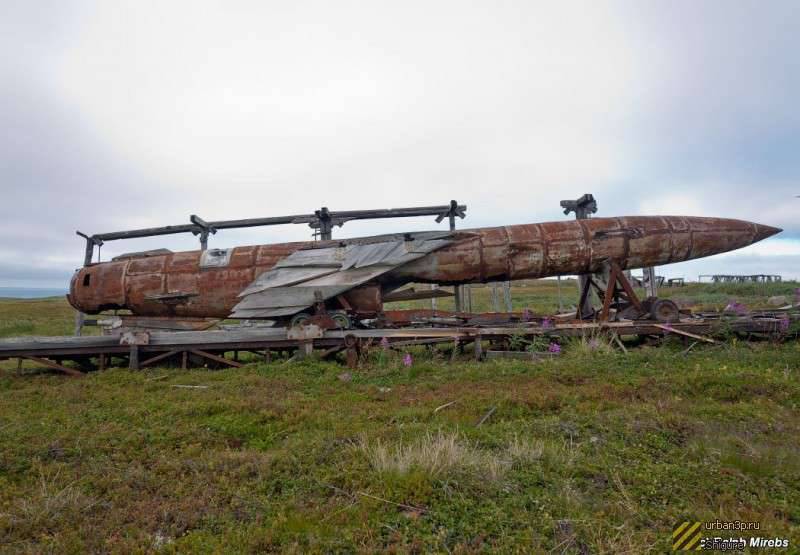
Educational model of the P-35B rocket on Fr. Kildin. Photo Urban3p.ru
The 2 Division was more fortunate. New owners, who did not have the opportunity to exploit it, carried out conservation. In the future, the object was partially returned to the service and opened to tourists. According to the latest data, after the return of the Crimea to Russia, the specialists of the Black Sea Fleet carried out all the necessary procedures, according to the results of which the Utes complex could again be used by the fleet. Now he complements the grouping of coastal missile forces and artillery.
The “101 Object” continued the service until the 1995 year. Despite all the problems, the 616-th OBPRP performed the tasks and defended the northern sea borders of the country. However, in the summer of 1995, the command decided to abandon the continued operation of the last Utes complex. The Ministry of Defense disbanded the regiment, and by the end of the year all the personnel went to the "mainland", leaving all the means of the missile complex on the island.
Coast of the Kola Peninsula and about. Kildin divides the relatively narrow strait, which affected the subsequent fate of the remaining missile complex. Scrap metal hunters appeared on the island and managed to inflict critical damage on the Rock in a relatively short time. In addition, the state of the complex was adversely affected by the harsh northern climate. As a result, only rusty remains of special equipment and crumbling structures with peeling paint remained on the island. A model of the P-35B rocket, used for training purposes, is of particular popularity among tourists visiting the island. It is hardly necessary to clarify that the state of this product, as well as the complex as a whole, leaves much to be desired.
The Utyos coastal missile systems are distinguished by a complex fate. The 101 Object complex did not survive the difficult nineties. The “100 object”, in turn, suffered significant losses, but after a long period of inactivity returned to the service and again could solve the tasks. Thanks to the specialists of the Black Sea Fleet, who returned him to work, the country again received a reliable means of protecting the southern maritime borders. Having sufficiently high characteristics, the Crimean complex "Cliff" can still continue to serve, complementing newer and more advanced systems.
Based on:
http://flot.sevastopol.info/
http://bratishka.ru/
http://kildin.ru/
http://rbase.new-factoria.ru/
http://bastion-opk.ru/
Shirokorad A.B. Weapons of the domestic fleet. 1945-2000. - Minsk: “Harvest”, 2001
Detailed photo review of the destroyed "101 Object":
http://lana-sator.livejournal.com/209537.html
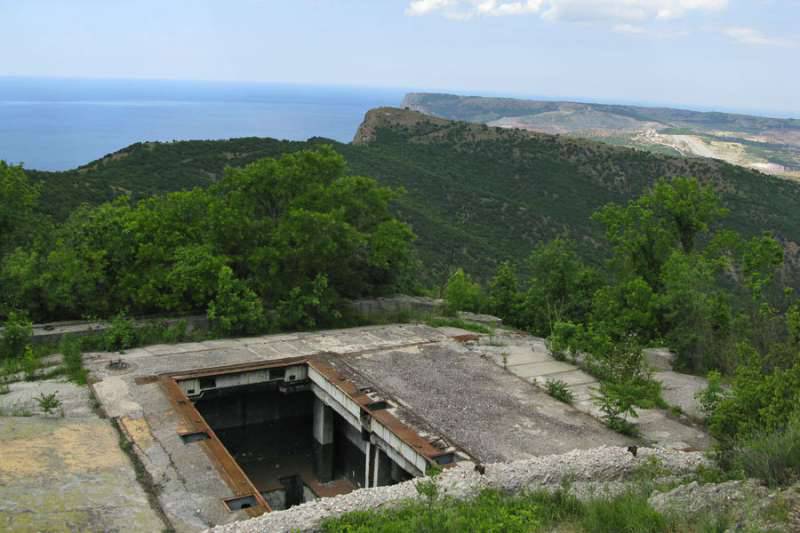
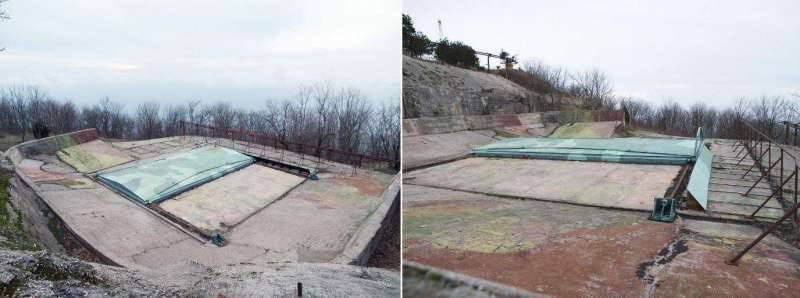
Information